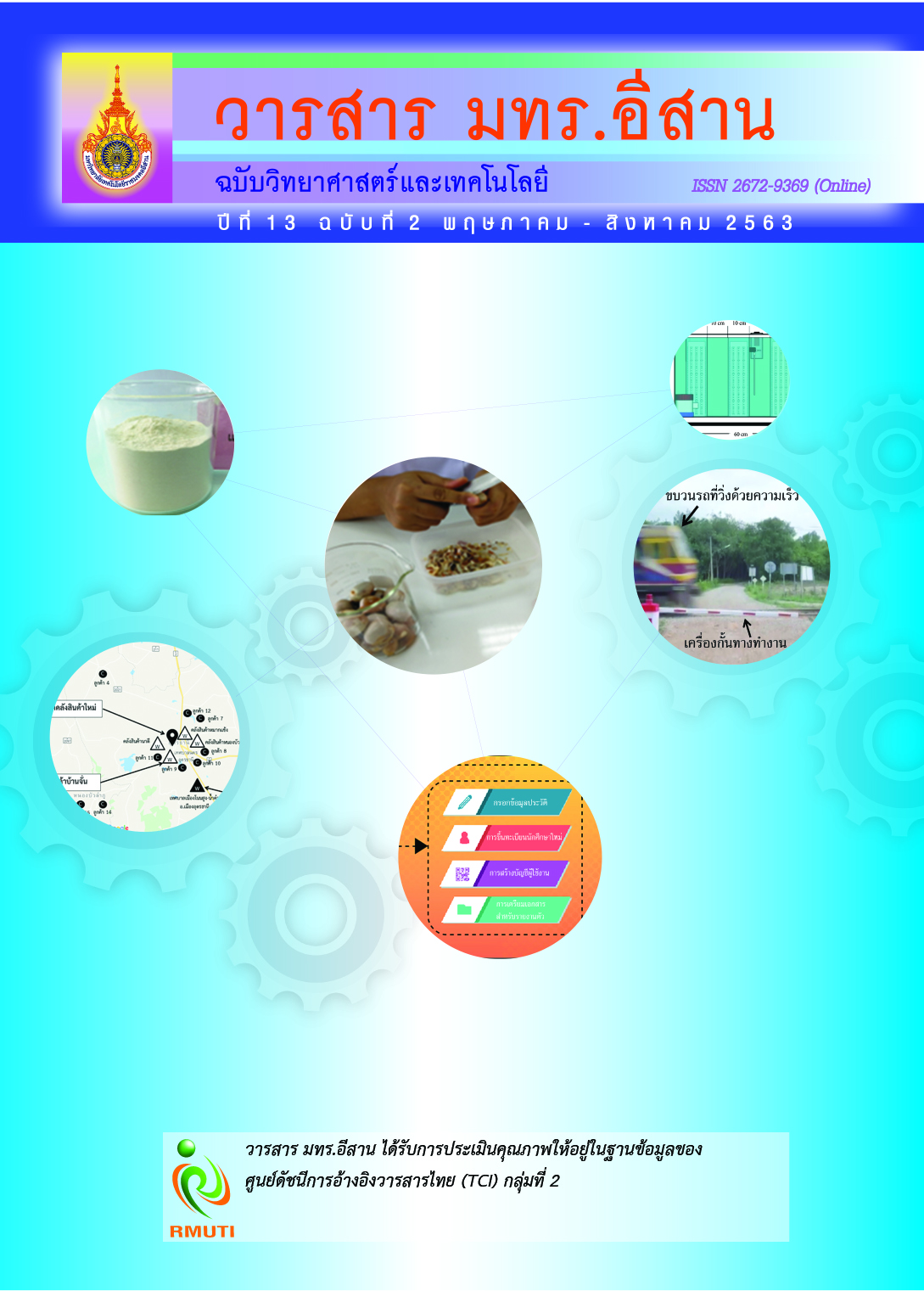การศึกษาอัตราส่วนที่เหมาะสมของงาดำและชนิดของสารให้ความหวานแทนนํ้าตาลต่อคุณภาพของสังขยางาดำ
Main Article Content
บทคัดย่อ
วัตถุประสงค์ของงานวิจัยนี้เพื่อศึกษาปริมาณของงาดำ และชนิดสารให้ความหวานแทนน้ำตาล ได้แก่ สตีเวีย และซูคราโรสต่อคุณภาพทางประสาทสัมผัสกายภาพ คุณค่าทางโภชนาการ และการยอมรับของผู้บริโภค โดยเตรียมสังขยาเสริมงาดำจำนวน 3 สูตร แปรผันอัตราส่วนที่แตกต่างกัน คือ ร้อยละ 5 10 และ 15 ของส่วนผสมทั้งหมด และนำไปวิเคราะห์คุณภาพด้านต่าง ๆ พบว่าคะแนนการทดสอบทางประสาทสัมผัสในด้านลักษณะปรากฏโดยรวม สี รสชาติ และความชอบโดยรวม สังขยาเสริมงาดำร้อยละ 10 มีคะแนน ความชอบมากกว่าร้อยละ 5 และ 15 ค่าความหนืด และค่าสี a* มีค่าเพิ่มขึ้น ส่วนค่าสี L* มีค่าลดลงอย่างมีนัยสำคัญทางสถิติ (p ≤ 0.05) จากการศึกษาผลของสารให้ความหวานแทนน้ำตาล 2 ชนิด ได้แก่ สตีเวีย และซูคราโลส พบว่าสังขยาเสริมงาดำร้อยละ 10 ที่ใช้ซูคราโลสเป็นสารให้ความหวานแทนน้ำตาลให้ผลการยอมรับ จากผู้ทดสอบชิมสูงกว่าสังขยาเสริมงาดำจากสตีเวีย โดยด้านรสชาติหวาน และความชอบโดยรวมมีความแตกต่างกันอย่างมีนัยสำคัญทางสถิติ (p ≤ 0.05) ส่วนค่าความหนืดและค่าสี (L* a* b*) ไม่มีความแตกต่างกันอย่างมีนัยสำคัญทางสถิติ (p > 0.05) ผลการวิเคราะห์คุณค่าทางโภชนาการพบว่า สังขยาเสริมงาดำจากซูคราโลสมีคุณค่าทางโภชนาการ ได้แก่ พลังงาน 200.33 กิโลแคลอรี่ ไขมัน 13.33 กรัม คาร์โบไฮเดรต 12.76 กรัม โปรตีน 7.33 กรัม ใยอาหาร 5.05 กรัม ความชื้น 64.98 กรัม เถ้า 1.60 กรัม นํ้าตาลทั้งหมด 4.05 กรัม แคลเซียม 394.57 มิลลิกรัม เหล็ก 1.57 มิลลิกรัม และฟอสฟอรัส 218.15 มิลลิกรัม การทดสอบยอมรับผู้บริโภคพบว่ายอมรับผลิตภัณฑ์ในระดับการยอมรับมาก โดยผู้บริโภคร้อยละ 90 ตัดสินใจซื้อเมื่อผลิตภัณฑ์วางจำหน่าย โดยให้เหตุผลว่าเป็นผลิตภัณฑ์ทางเลือกเพื่อสุขภาพร้อยละ 45
Article Details
เอกสารอ้างอิง
SME Cheechongruay. (2019). Pungpunglava Franchise Khanompungsaitaluk Longtoonngai Kumraigurnkrung. Access (18 March 2020). Available (http://cheechongruay.smartsme.co.th/content/22264)
Daedkhulchon, J. (2014). Thai Dessert Book 2. Bangkok: Diamond Publisher
Bureau of Nutrition, Department of Health. (2011). Good Health Starts at Foods Reduce Sweet, Salty, add More Vegetables, Fruits. In: Saleepan, S., and Sukjai, S. (eds.). Bangkok: Veterans Organization Printing Factory.
Kee-ariyo, C., Apinya, M., Photchanee, B., and Nanoln, D. (2012). The Development Thai Dessert form Local Herbs. Research Report, Faculty of Home Economics Technology, Rajamangala University of Technology Phra Nakhon
Mekrawee, N., Teeranuch, C., Onanong, T., Narongchai, K., and Kraiyarach, P. (2016). Tofu Egg Custard Sauce with Black Sesame. Home Economics Journal. Vol. 59, No. 3, pp. 26-35
Sagepakdee, N. (2001). Development of Semi-Finished Black Sesame Soup Products. Thesis Master Degree of Home Economics, Home Economics, Faculty of Agriculture, Kasetsart University
Jacob, M., Tripathi, A. M., Yadav, G., and Saha, S. (2016). Nutritive and Non-Nutritive Sweeteners: A Review. International Journal of Oral Health and Medical Research. Vol. 2, No. 5, pp. 149-153
Chermongkhl, W. (2008). Sweeteners: Use and Safety. Thai Pharmaceutical and Health Science Journal. Vol. 3, No. 1, pp. 161-168
Hemrangkha, P. (2011). The Development of Bread Sticks with Black Sesame: A Case Study of Khakai Company Limited. Thesis Master Degree of Arts, Development Strategy, Rajabhat Rajanagarindra University
Bureau of Nutrition, Department of Health. (2001). Nutritive Values of Thai Foods. In: Boonvisut, S. (eds.). Bangkok: Department of Health
AOAC. (2000). Official Methods of Analysis of AOAC International. 17th ed. Maryland, USA: AOAC International
AOAC. (2005). Official Methods of Analysis of AOAC International. 18th ed. Maryland, USA: AOAC International
Vanidbhuncha, K. (2007). Data Analysis SPSS for Windows. 10th ed. Bangkok: Thamasan Publishers Ltd.
Deveries, L. J. and Reinhold, V. N. (1992). Controlling Dietary Fiber in Food Products. New York: Van Nostrand Reinhold
Srisangwan, N. (2012). Nutritional Improvement of A-lua and Foi-Thong Desserts by Using Non sugar Sweeteners. Thesis Master Degree of Science, Food Technology, Faculty of Engineering and Industrial Technology, Silpakorn University
Khamwachiraphitak, M., Payom, R., Morragot, K., Suvitchaya, S., Kanokwan, P., Benjang, A., Songpoltanarit, M., and Benjawan, B. (2008). Influence of Fructose Syrup and Sucralose on Some Characteristics of Mixed Fruit Jams. Research Journal and Development of Valaya Alongkorn Under the Royal Patronage. Vol. 11, No. 2, pp. 15-23
Tanthipiriya, J. (2006). Partial Substitution of Sugars by Sweeteners “Sucralose” in Pomelo Jam Product. Nakhonpathom: Nakhonpathom Rajabhat University
Akesuwan, A. (2009). Quality of Reduced-Fat Chiff on Cakes Prepared with Erythritol-Sucralose as Replacement for Sugar. Pakistan Journal of Nutrition. Vol. 8, Issue 9, pp. 1383-1386. DOI: 10.3923/pjn.2009.1383.1386
Lin, S. D., Hwang, C. F., and Yeh, C. H. (2003). Physical and Sensory Characteristics of Chiff on Cake Prepared with Erythritol as Replacement for Sucrose. Journal of Food Science. Vol. 68, Issue 6, pp. 2107-2110. DOI: 10.1111/j.1365-2621.2003.tb07027.x
Vongyeam, W. (2009). Supplementing Rice Flour Cookies with Protein Extracted from Black Sesame Seeds. Thesis Master Degree of Science, Agro-Industrial Product Development, Faculty of Agro-Industry, Chiang Mai University
Klinkajorn, S. (2002). Production of Black Sesame Sesame indicum Linn. Butter. Thesis Master Degree of Science in Food Technology, Food Technology, Faculty of Science, Chulalongkorn University
Bunsit, K. and Teerapon, B. (2014). Value of Unroasted Black Sesame Seed Cake. Journal of Science and Technology, Ubon Ratchathani University. Vol. 16, No. 2, pp. 47-54
Phuksuksakul, A. (2015). Food for Family. Food and Nutrition Department, Faculty of Home Economics Technology, Rajamangala University of Technology Thanyaburi


